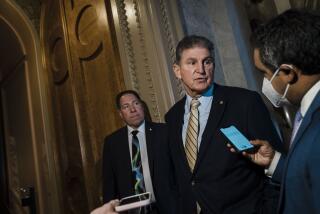Administration Park Plan Is Setting Off Sparks
- Share via
WASHINGTON — As Congress rushes through its preelection calendar, the Clinton administration and many of its usual allies among environmentalists are headed for a potentially divisive clash over a plan that critics fear could turn national parks into logo-polluted advertisements for corporate America.
An administration proposal that could be taken up by Congress within days would allow corporate “sponsorship” of national parks in exchange for private-sector contributions to help make up for shortfalls in federal spending on the parks.
The proposal is one of several affecting the environment that are being discussed in congressional corridors as GOP leaders, uncertain whether they will be in as strong a position in January, seek action on legislation that has been bottled up for nearly two years.
“These are the most dangerous hours in the legislative year. This is a very dangerous situation for the environment,” said Rep. George Miller (D-Martinez), the ranking Democrat on the House Resources Committee.
But Rep. Sherwood Boehlert (R-N.Y.), a key figure among environmental moderates within the Republican congressional majority, said he expects his party to approach the proposals cautiously. Boehlert said that House Speaker Newt Gingrich (R-Ga.) has recognized that the GOP’s assault on environmental regulations in 1995 carried a high political price and that “we did not deal with environment in a responsible way.”
Among the proposals in play are measures to increase logging in Alaska’s Tongass National Forest as well as oil drilling in that state, hold down grazing fees on environmentally sensitive federal lands, restrict the government from raising gasoline-mileage standards for automobiles and light trucks and overturn an administration effort to restrict logging in some of the nation’s oldest forests.
The parks proposal was the main topic recently at what some participants said became a heated private meeting between Deputy Interior Secretary John Garamendi, a former California legislator and former state insurance commissioner, and a group of environmental activists. One meeting participant said that, except for Garamendi, “virtually everyone in the room was vehement in opposing” the park-financing plan.
Garamendi defended the proposal as a way to work around fiscal constraints facing the federal government. “We’re looking at a 10-year period of no significant [budget] increases for the Department of Interior,” Garamendi told the group, according to an aide and the notes of one of the environmentalists. “Given the public attitude these days, we won’t see the money available through the normal budgeting process. Therefore, we’re searching for a way of dealing with this.”
The National Park Service has experimented with such a plan on a limited basis, with private sponsors contributing to specific projects.
But, said Donald Hellmann, the Park Service’s chief of legislation, the current plan would allow the parks “to get a much bigger amount of money on a continuing basis.”
“It’s not unlikely we could see contributions in the range of $50 million to $100 million per year. It would be a nice supplement to our budget,” he said.
Critics fear that the parks plan would give the secretary of the Interior too much discretion in determining when to accept corporate contributions and when to reject them, leaving open the possibility that corporate dollars could improperly tilt department policy.
A company seeking government permission to develop federal land, for example, “could become a major sponsor of the Park Service,” said Debbie Sease, a Sierra Club legislative specialist. “If the Park Service becomes too dependent on the contribution . . . the Department of the Interior could try to keep their corporate sponsors happy” with decisions that conflict with broader conservation goals, she warned.
At the moment, the proposal is part of legislation to deal with such diverse issues as placing a hydroelectric power plant in Glacier Bay National Park in Alaska, expanding the access given to snowmobiles and motorboats in Minnesota’s Boundary Waters and limiting expansion of the Shenandoah National Park in Virginia.
The legislation also would satisfy some of the environmentalists’ concerns by protecting from development such areas as the Sterling Forest, a heavily wooded swatch of land on the otherwise heavily developed New Jersey-New York border, and the Presidio, the former Army base in San Francisco that offers a well-manicured vantage point overlooking the Pacific Ocean and San Francisco Bay.
But in the closing days of a congressional session, legislation often gets carved into small pieces, or repackaged. Controversial proposals often are attached to unrelated, must-pass measures, such as spending bills.
Thus, there is talk in Congress of attaching the park-financing plan to a measure allocating funding for the Interior Department in the next federal fiscal year, which starts Oct. 1.
More to Read
Sign up for Essential California
The most important California stories and recommendations in your inbox every morning.
You may occasionally receive promotional content from the Los Angeles Times.










